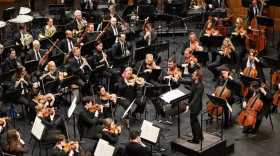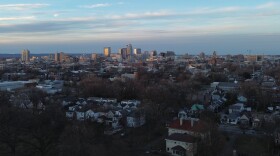Temperatures dropped and twilight fell for a brief moment across parts of Kentucky, as the moon passed between the Earth and the sun. Then, in a matter of minutes, the light returned.
A dozen western Kentucky counties observed a total solar eclipse on Monday – the last that the Commonwealth will see in the 21st century. Other parts of the state, like Louisville, Lexington and Bowling Green, saw over 90% of the sun blocked by the moon.
Thousands of people traveled to parts of the Commonwealth in the path of totality, including cities like Paducah and Henderson.
For Paty Fuentes of Washington, D.C., the 12-hour drive to Paducah was a trip over a year in the making. It was a strategic choice for the eclipse chaser, as she said Paducah was one of the destinations in the path of totality that she said historically had clear skies this time of year.
The one-and-a-half minutes of darkness around 2 p.m. local time made her planning and travel pay off.
“I was like ‘oh my God, this is the most beautiful thing,’ – and I’ve given birth before – so this is the most beautiful thing I’ve ever seen in my life. It was amazing, it was amazing,” she said.
Marge Stack, 76, and her husband Bob, 83, traveled from Murphy, North Carolina, to camp out in Kentucky and to witness in downtown Paducah what she said could be the last total eclipse they’ll see in their lifetimes.
“Now, we had people that thought we were nuts for doing this, and I said we’re gonna do it anyway,” she said. “And then we got other friends that say, ‘awesome.’ And you know, at our age, why not? If we can do it, we can do it, and this is it, so we’re here.”
Joanna Holland of Chattanooga, Tennessee, saw a total solar eclipse in 2017. While she could have seen a partial eclipse closer to home, she said it’s not the same as experiencing totality.
“I think what was the coolest part about it is that even when there was just a tiny sliver of the Sun left, there was still so much daylight. It wasn't until it was completely covered [that it] got dark,” Holland said. “People are like, ‘oh, yeah, I've seen it, or I saw most of it,’ but it's different if it's totality because even when there's just a speck of sun still remaining, you're like, ‘wow, I mean, it still looks like daylight out here.’ And once it [was] covered, it got dark and things changed.”
Louisville saw ninety-nine percent of the solar eclipse Monday. Folks popped out of offices and cafes as the peak of the eclipse hit just after 3 p.m. eastern time. Pockets of people clumped together outside the PNC building and along Main Street, passing around pairs of specialty glasses that let them safely gaze at the dwindling sun.
Children and their families gathered outside the Kentucky Science Center to watch the big show in the sky. The temperature dipped and the light dimmed as the moon blocked most — but not quite all — of the sun.
“Why is it so dark?" one kid asked. "Oh my God, this is scary!”
Farther west, well over 100 people were at the planetarium on the campus of Western Kentucky University in Bowling Green to witness the astronomical phenomenon. WKU math professor Dan Clark brought his family, including a 4-year-old daughter and 15-month old son.
“This doesn't happen very often and we thought the kids would like to see it so we thought we’d come out,” Clark said. Clark’s daughter, Dolores, wore her eclipse glasses and said she was having a good time.
“I love it. It looks really cool.”
The next time a total solar eclipse will be visible in the contiguous United States is in 2044.
Louisville Public Media reporter Morgan Watkins and WKU Public Radio reporter Jacob Martin contributed to this report.











